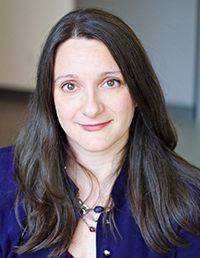Applied Public Health Chair – Candace Nykiforuk

Candace Nykiforuk, BA, MA, PhD, is an Associate Professor at the School of Public Health, University of Alberta. Dr. Nykiforuk obtained her BA in Geography at the University of Alberta, MA in Recreation and Leisure Studies, and PhD in Health Studies and Gerontology. Dr. Nykiforuk is a health geographer as well as a population health researcher with expertise in the area of program and policy research at community and provincial levels. She brings this multidisciplinary experience into her role as CIHR/PHAC Applied Public Health Chair on the topic of improving built and social environments through the strategic development and evaluation of population health interventions (PHI).
The decision-making collaborators on Dr. Nykiforuk’s Chair in Applied Public Health are: James Talbot, M.D., PhD, FRCPC; Donna Hastings, CEO and Kate Chidester, Vice President Health & Research, Alberta, NWT & Nunavut Heart and Stroke Foundation; Maureen Dobbins, RN, PhD, Scientific Director, National Collaborating Centre for Methods and Tools; William Wells, CEO, Alberta Recreation and Parks Association; and Sue Hutton, Manager Marketing, Sponsorship and Programs, Strathcona County: Recreation, Parks and Culture.
Dr. Nykiforuk’s Chair
There are important gaps in knowledge related to population health interventions, specifically in the realm of supportive environments and healthy public policy. Research in the area of built environments and health reveal crucial knowledge on how environments can promote or hinder well-being and equity. However, this is still an emerging field, which leaves critical gaps regarding transferability (e.g.: setting characteristics) as well as methodology (e.g.: sophisticated analysis and rigorous evaluation). There are also gaps related to the update and implementation of across provinces and facilitating non-expert participation in the local and provincial policy processes.These key gaps guide Dr. Nykiforuk’s research.
Chair Objective
Dr. Nykiforuk, as an Applied Public Health Chair, aims to address these gaps by building on the Policy, Location, and Access in the Community Environments (PLACE) research program. This program systematically investigates the relationships between place, policy, and health by evaluating, developing, and mobilizing evidence related to public health interventions and other strategies to promote wellness and chronic disease prevention throughout the life-course. The PLACE program is comprised of two synergistic research areas: Supportive Environments for Health and Healthy Public Policy as population health interventions.
Moving forward, Dr. Nykiforuk plans to:
- Implement and evaluate community based public health interventions on the built and social environment relative to health outcomes.
- Investigate how government-led PHIs impact health and health equity.
- Develop and evaluate evidence-based tools to support healthy public policy.
- Design innovative, interdisciplinary methods to assess the built, social, and policy environments.
- Engage and collaborate with decision-makers and other partners to develop PHIs, investigate their impact, and transfer knowledge to other stakeholders.
- Provide active mentorship to researchers at early stages in their career.
Community engagement, capacity building, methodological innovation, interdisciplinary evaluation, and strategic knowledge translation are key elements embedded within the research projects.
Over the past year, Dr. Nykiforuk has been working in close partnership with her APHC collaborators and their stakeholders on the continuation of key projects and the development of new initiatives. Here are just a few exciting examples:
- Building from our past existing work on the Policy Readiness Tool, we worked with school community partners to develop an Idea Readiness Tool to help school communities assess readiness for a new idea and strategies for taking action on wellness initiatives (APHC objective: develop and evaluate evidence-based tools to support healthy public policy).
- We are working closely with community partners to share, with practice and research audiences, the knowledge we gained from our recently completed, collaborative, multi-year investigation of community investment in recreation spaces relative to health equity and access to facilities (APHC objective: investigate how government-led PHIs impact health and health equity).
- In November 2016, we led a multi-sectoral, pan-Canadian meeting to set priorities for practice and research targeting physical activity in rural, remote, and northern communities (APHC objective: engage and collaborate with decision-makers and other partners to develop PHIs, investigate their impact, and transfer knowledge to other stakeholders).
Want to know more?
To learn more about Dr. Nykiforuk’s research and projects, please visit:
She can be followed on Twitter: @nykiforuk_c and @PLACE_lab
Publications
Belon AP, Nieuwendyk LM, Vallianatos H, Nykiforuk CIJ. (2016). Community lenses revealing the role of sociocultural environment on physical activity. American Journal of Health Promotion, 30(3):e92-e100.
Olstad DL, Campbell EJ, Raine KD, Nykiforuk CI. (2015). A multiple case history and review of adoption, diffusion, implementation and impact of provincial daily physical activity policies in Canadian schools. BMC Public Health 15:385. DOI: 10.1186/s12889-015-1669-6. PubMed PMID: 25885026.
- Date modified: